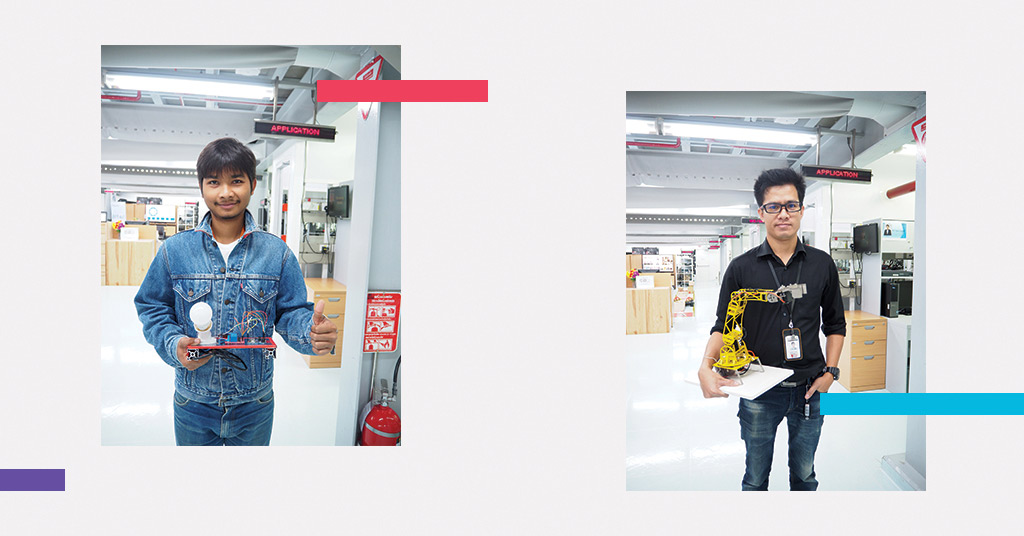A few small sensors and a Raspberry Pi control the watering system in Taweesak Phuengprasit’s family’s farm in the Ang Thong province in Thailand. Phuengprasit, who has been working as a technician in Western Digital’s hard drive manufacturing plant for the last 10 years, picked up his smart farming skills at the factory.
“Through our smart factory training, I got to know about this technology, how to use a controller, a Raspberry Pi, sensors, and the code to create a smart farm,” he said. “My mom loves it. She knows her bananas and mangos are watered, so she is finally free to do other things,” he said.
Phuengprasit is one of thousands of Western Digital factory employees undergoing upskilling and reskilling paths. With the company’s hard drive and flash factories becoming some of the smartest in the world, the skills to operate them are changing dramatically.
The smart factory
Jackie Jung is the Chief of Staff and Strategy of Global Operations at Western Digital and the driving force behind its adoption of fourth industrial revolution technologies. Emerging, the fourth industrial revolution (4IR) is defined by the opportunities afforded by cyber-physical systems. It’s not bound to a single technology but rather how the combination of technologies like artificial intelligence (AI), virtual reality, and the Internet of Things (IoT) are augmenting the way we live, work, and interact.
“With a global zettabyte growth for hard drives and exabyte scale growth for flash, we have to scale up productivity, deliver best-in-class quality, and improve competitiveness and value creation, all at the same time,” Jung said. “These daunting tasks cannot be solved simultaneously without the help of intelligent systems,” she said.
According to Jung, the company has implemented many cutting-edge use cases of real-time analytics, machine-to-machine connectivity, computer vision, robotics, and predictive operations powered by AI. Yet even where cognitive automation has taken over the production line, Western Digital’s manufacturing workforce remained intact. “Contrary to conventional thinking, humans in the smart factory aren’t obsolete,” she said. “In fact, as algorithms take over certain tasks and provide deeper insights, it grants humans more initiative and creativity,” she said.

New skills
To reskill and upskill its factory workforce, Western Digital has embarked on a vast effort of collaborations with government agencies, local universities, and polytechnics. Factories have set up Industrial Internet of Things (IIoT) labs and dedicated learning centers.
Yet training isn’t just about formal or academic learning. Gamification, such as DIY robotics workshops using Arduino and Raspberry Pi tools, offers a hands-on way to learn about embedded and integrated systems.
Phanomkorn Sangrung has been working as a technician specialized in tooling design at Western Digital’s hard drive factory for over 11 years. He had never experienced augmented or virtual reality until he was introduced to it in his 4IR training in 2018.
Today, Sangrung has created an entire simulation of intricate production machines he uses to instruct new hires. “Before, I had to train people on the production floor, where there was little opportunity to show how the machines run from the inside,” Sangrung said. “Now, using a 3D simulation and a VR headset, one can look at the inner mechanics from any angle. I can transfer complex knowledge in a much simpler way, without intervening in the production flow,” he said.
Reskilling the world
According to the World Economic Forum, nearly two-thirds of today’s school children will work in jobs that don’t exist yet. These future-needed skills aren’t limited to technology alone. Both Phuengprasit and Sangrung named systematic problem solving, design thinking, and communication as the most essential skills they have acquired.
“A factory used to be a place of hard skills. Of equations, technicians, and engineers,” said Philip Bernard, Vice President Global HDD Operations at Western Digital. “But to be successful, we need dreamers. We need thinkers. We need people with imagination and ideas to ask, ‘why can’t we do this?’ Then we need the doers who can take those ideas and make them work,” he said.
4IR is a journey
Western Digital’s 4IR adoption didn’t happen overnight. “At first, people were very nervous about letting an algorithm take control over a tool or an existing process,” said George Ng, the Global Director of AI and IoT Operations at Western Digital, and the technical mind behind the company’s 4IR technology revamp. “Upskilling our assembly engineers by introducing them to machine learning helped bridge the gap between the production process and analytics,” he said.
Success followed. At first small, but it could quickly scale. “Today, we deploy intelligence at every step,” said Ng. “Using a digital-enabled assembly process and predictive maintenance, we have reduced HDD quality deviations by 80%. With IoT technologies, we have brought 21% OEE improvement in flash production, our ‘lights-out’ automation brought a dramatic 360% increase in productivity, and we can deliver customers much more customization in a shorter cycle,” he said.
“It’s about improving everything,” said Panuwat Rodchom, Manager Engineer in Western Digital’s Advance Manufacturing Engineering. “That includes the quality of life of those in the factory and those in the communities around us,” he said. The company’s STEM and youth programs have won several Thailand HR innovation awards and the 2020 American Chamber of Commerce Corporate Social Responsibility award.
Some say the fourth industrial revolution is the first revolution to name itself before it even started. That’s because it is as much about a vision and an opportunity as it is about technology. “It’s the human aspect that will make or break a 4IR implementation,” said Bernard.
